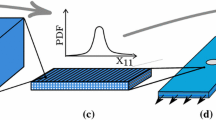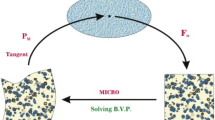Abstract
Composite materials and structures may be characterized at different length scales, ranging from the micro-scale at the fiber–matrix level, meso-scale at the lamina–laminate level, to structural macro-scale. However, uncertainties in material properties and geometric parameters due to manufacturing, defects and assembly processes may occur at various length scales. This paper presents a computational framework for stochastic analysis of composites with consideration of stochastic parameters at micro- and meso-scales. The novelty of the proposed framework is the integration of the spectral stochastic finite element method and asymptotic homogenization method within a finite element technique, which was implemented through \(\hbox {ABAQUS}^{\circledR }\). This spectral stochastic homogenization method efficiently predicts the propagation of uncertainties from the constituent to ply levels. The derived probability distributions of effective properties were verified by Monte Carlo simulation. Another novelty is the study of the influence of stochastic parameters at both micro-scale and meso-scale on the failure prediction of composite structures, without assumptions of probabilistic characteristic of ply properties commonly used in a single-scale stochastic analysis. The up-scaled uncertainties combined with other randomness at meso-scale (strength properties and ply orientations) are provided as the input of meso-scale stochastic strength analysis of a quasi-isotropic laminate based on classical lamination theory (CLT) and ply discount. The probability distribution of first-ply failure and ultimate failure loads are obtained and their sensitivity factors with respect to input variations are presented.













Similar content being viewed by others
References
Andersons J, Joffe R, Spārniņš E (2008) Statistical model of the transverse ply cracking in cross-ply laminates by strength and fracture toughness based failure criteria. Eng Fract Mech 75(9):2651–2665
Arregui-Mena JD, Margetts L, Mummery PM (2016) Practical application of the stochastic finite element method. Arch Comput Methods Eng 23(1):171–190
Balokas G, Czichon S, Rolfes R (2017) Neural network assisted multiscale analysis for the elastic properties prediction of 3d braided composites under uncertainty. Compos Struct 183:550–562
Chakraborty S, Mandal B, Chowdhury R, Chakrabarti A (2016) Stochastic free vibration analysis of laminated composite plates using polynomial correlated function expansion. Compos Struct 135:236–249
Chamis CC (2004) Probabilistic simulation of multi-scale composite behavior. Theor Appl Fract Mech 41(1):51–61
Charmpis DC, Schuëller GI, Pellissetti MF (2007) The need for linking micromechanics of materials with stochastic finite elements: a challenge for materials science. Comput Mater Sci 41(1):27–37
Chen X, Qiu ZP (2018) A novel uncertainty analysis method for composite structures with mixed uncertainties including random and interval variables. Compos Struct 184:400–410
Chen NZ, Soares CG (2008) Spectral stochastic finite element analysis for laminated composite plates. Comput Methods Appl Mech Eng 197(51):4830–4839
Chen N, Yu DJ, Xia BZ, Liu J, Ma ZD (2017) Interval and subinterval homogenization-based method for determining the effective elastic properties of periodic microstructure with interval parameters. Int J Solids Struct 106:174–182
Chiachio M, Chiachio J, Rus G (2012) Reliability in composites—a selective review and survey of current development. Compos Part B Eng 43(3):902–913
Chung DB, Gutiérrez MA, de Borst R (2005) Object-oriented stochastic finite element analysis of fibre metal laminates. Comput Methods Appl Mech Eng 194(12):1427–1446
Cui XY, Hu XB, Zeng Y (2017) A copula-based perturbation stochastic method for fiber-reinforced composite structures with correlations. Comput Methods Appl Mech Eng 322:351–372
Dey S, Mukhopadhyay T, Adhikari S (2015) Stochastic free vibration analyses of composite shallow doubly curved shells—a Kriging model approach. Compos B Eng 70:99–112
Dey S, Mukhopadhyay T, Adhikari S (2017) Metamodel based high-fidelity stochastic analysis of composite laminates: a concise review with critical comparative assessment. Compos Struct 171:227–250
Ghanem RG, Spanos PD (2003) Stochastic finite elements: a spectral approach. Courier Corporation, North Chelmsford
Jeong HK, Shenoi RA (2000) Probabilistic strength analysis of rectangular FRP plates using Monte Carlo simulation. Comput Struct 76(1):219–235
Kamiński M, Kleiber M (2000) Perturbation based stochastic finite element method for homogenization of two-phase elastic composites. Comput Struct 78(6):811–826
Karsh PK, Mukhopadhyay T, Dey S (2018) Spatial vulnerability analysis for the first ply failure strength of composite laminates including effect of delamination. Compos Struct 184:554–567
Kaw Autar K (2005) Mechanics of composite materials. CRC Press, Boca Raton
Kepple J, Herath MT, Pearce G, Prusty BG, Thomson R, Degenhardt R (2015) Stochastic analysis of imperfection sensitive unstiffened composite cylinders using realistic imperfection models. Compos Struct 126:159–173
Lal A, Singh BN, Kumar R (2009) Effects of random system properties on the thermal buckling analysis of laminated composite plates. Comput Struct 87(17):1119–1128
Lal A, Singh BN, Kale S (2011) Stochastic post buckling analysis of laminated composite cylindrical shell panel subjected to hygrothermomechanical loading. Compos Struct 93(4):1187–1200
Lekou DJ, Philippidis TP (2008) Mechanical property variability in FRP laminates and its effect on failure prediction. Compos B Eng 39(7–8):1247–1256
Li JQ, Tian XP, Han ZJ, Narita Y (2016) Stochastic thermal buckling analysis of laminated plates using perturbation technique. Compos Struct 139:1–12
Liu D, Fleck NA, Sutcliffe MPF (2004) Compressive strength of fibre composites with random fibre waviness. J Mech Phys Solids 52(7):1481–1505
Lopez RH, Miguel LFF, Belo IM, Cursi JES (2014) Advantages of employing a full characterization method over form in the reliability analysis of laminated composite plates. Compos Struct 107:635–642
Lorca JL, González C, Molina-Aldareguía JM, Segurado J, Seltzer R, Sket F, Rodríguez M, Sádaba S, Muñoz R, Canal LP (2011) Multiscale modeling of composite materials: a roadmap towards virtual testing. Adv Mater 23(44):5130–5147
Ma J, Temizer I, Wriggers P (2011) Random homogenization analysis in linear elasticity based on analytical bounds and estimates. Int J Solids Struct 48(2):280–291
Nakayasu H, Maekawa Z (1997) A comparative study of failure criteria in probabilistic fields and stochastic failure envelopes of composite materials. Reliab Eng Syst Saf 56(3):209–220
Ngah MF, Young A (2007) Application of the spectral stochastic finite element method for performance prediction of composite structures. Compos Struct 78(3):447–456
Noh HC, Park T (2011) Response variability of laminate composite plates due to spatially random material parameter. Comput Methods Appl Mech Eng 200(29):2397–2406
Onkar AK, Upadhyay CS, Yadav D (2007) Probabilistic failure of laminated composite plates using the stochastic finite element method. Compos Struct 77(1):79–91
Panayirci HM, Schuëller GI (2011) On the capabilities of the polynomial chaos expansion method within SFE analysis—an overview. Arch Comput Methods Eng 18(1):43–55
Perić D, de Souza Neto EA, Feijóo RA, Partovi M (2011) On micro-to-macro transitions for multi-scale analysis of non-linear heterogeneous materials: unified variational basis and finite element implementation. Int J Numer Meth Eng 87(1–5):149–170
Pimenta S (2017) A computationally-efficient hierarchical scaling law to predict damage accumulation in composite fibre-bundles. Compos Sci Technol 146:210–225
Pimenta S, Pinho ST (2013) Hierarchical scaling law for the strength of composite fibre bundles. J Mech Phys Solids 61(6):1337–1356
Sakata S, Ashida F, Kojima T, Zako M (2008) Three-dimensional stochastic analysis using a perturbation-based homogenization method for elastic properties of composite material considering microscopic uncertainty. Int J Solids Struct 45(3):894–907
Sánchez-Heres LF, Ringsberg JW, Johnson E (2014) Influence of mechanical and probabilistic models on the reliability estimates of fibre-reinforced cross-ply laminates. Struct Saf 51:35–46
Scarth C, Cooper JE, Weaver PM, Silva GHC (2014) Uncertainty quantification of aeroelastic stability of composite plate wings using lamination parameters. Compos Struct 116:84–93
Sepahvand K (2016) Spectral stochastic finite element vibration analysis of fiber-reinforced composites with random fiber orientation. Compos Struct 145:119–128
Shaw A, Sriramula S, Gosling PD, Chryssanthopoulos MK (2010) A critical reliability evaluation of fibre reinforced composite materials based on probabilistic micro and macro-mechanical analysis. Compos B Eng 41(6):446–453
Soden PD, Hinton MJ, Kaddour AS (1998) Lamina properties, lay-up configurations and loading conditions for a range of fibre-reinforced composite laminates. Compos Sci Technol 7(58):1011–1022
Sriramula S, Chryssanthopoulos MK (2009) Quantification of uncertainty modelling in stochastic analysis of frp composites. Compos A Appl Sci Manuf 40(11):1673–1684
Stefanou G (2009) The stochastic finite element method: past, present and future. Comput Methods Appl Mech Eng 198(9):1031–1051
St-Pierre L, Martorell NJ, Pinho ST (2017) Stress redistribution around clusters of broken fibres in a composite. Compos Struct 168:226–233
Swolfs Y, Verpoest I, Gorbatikh L (2016) A review of input data and modelling assumptions in longitudinal strength models for unidirectional fibre-reinforced composites. Compos Struct 150:153–172
Tay TE, Liu G, Tan VBC, Sun XS, Pham DC (2008) Progressive failure analysis of composites. J Compos Mater 42(18):1921–1966
Tootkaboni M, Graham-Brady L (2010) A multi-scale spectral stochastic method for homogenization of multi-phase periodic composites with random material properties. Int J Numer Meth Eng 83(1):59–90
Van Vinckenroy G, De Wilde WP (1995) The use of Monte Carlo techniques in statistical finite element methods for the determination of the structural behaviour of composite materials structural components. Compos Struct 32(1–4):247–253
Vijaya Kumar RL, Bhat MR (2015) Probabilistic stress variation studies on composite single lap joint using Monte Carlo simulation. Compos Struct 121:351–361
Vinogradov V, Hashin Z (2005) Probabilistic energy based model for prediction of transverse cracking in cross-ply laminates. Int J Solids Struct 42(2):365–392
Wu WF, Cheng HC, Kang CK (2000) Random field formulation of composite laminates. Compos Struct 49(1):87–93
Xiu DB (2010) Numerical methods for stochastic computations: a spectral method approach. Princeton University Press, Princeton
Zhao LB, Shan MJ, Liu FR, Zhang JY (2017) A probabilistic model for strength analysis of composite double-lap single-bolt joints. Compos Struct 161:419–427
Zhou XY, Gosling PD, Pearce CJ, Kaczmarczyk Ł, Ullah Z (2016) Perturbation-based stochastic multi-scale computational homogenization method for the determination of the effective properties of composite materials with random properties. Comput Methods Appl Mech Eng 300:84–105
Zhou XY, Gosling PD, Pearce CJ, Ullah Z, Kaczmarczyk Ł (2016) Perturbation-based stochastic multi-scale computational homogenization method for woven textile composites. Int J Solids Struct 80:368–380
Zhou XY, Gosling PD, Ullah Z, Kaczmarczyk Ł, Pearce CJ (2016) Exploiting the benefits of multi-scale analysis in reliability analysis for composite structures. Compos Struct 155:197–212
Zhou XY, Gosling PD, Ullah Z, Kaczmarczyk Ł, Pearce CJ (2017) Stochastic multi-scale finite element based reliability analysis for laminated composite structures. Appl Math Model 45:457–473
Acknowledgements
The support of the research scholarship for the first author and the research Grant (No. R265000523646) from NUS are gratefully acknowledged.
Author information
Authors and Affiliations
Corresponding author
Additional information
Publisher's Note
Springer Nature remains neutral with regard to jurisdictional claims in published maps and institutional affiliations.
Rights and permissions
About this article
Cite this article
Zhi, J., Tay, TE. Computational structural analysis of composites with spectral-based stochastic multi-scale method. Multiscale and Multidiscip. Model. Exp. and Des. 1, 103–118 (2018). https://doi.org/10.1007/s41939-018-0009-9
Received:
Accepted:
Published:
Issue Date:
DOI: https://doi.org/10.1007/s41939-018-0009-9




